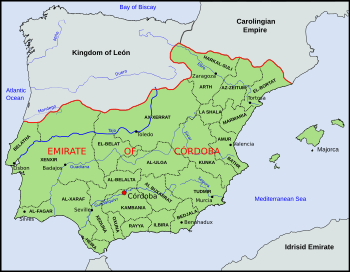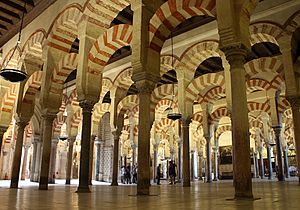Emirate of Córdoba facts for kids
Quick facts for kids
Emirate of Córdoba
|
|||||||||
|---|---|---|---|---|---|---|---|---|---|
| 756–929 | |||||||||

Emirate of Córdoba in 929 (green)
|
|||||||||
| Capital | Córdoba | ||||||||
| Common languages | Andalusian Arabic, Berber, Mozarabic, Medieval Hebrew | ||||||||
| Religion | Sunni Islam, Judaism, Roman Catholicism | ||||||||
| Government | Islamic absolute monarchy | ||||||||
| History | |||||||||
|
• Abd al-Rahman I proclaimed emir of Córdoba
|
15 May 756 | ||||||||
|
• Abd al-Rahman III proclaimed caliph of Córdoba
|
16 January 929 | ||||||||
| Currency | Dirham | ||||||||
|
|||||||||
| Today part of | Portugal Spain |
||||||||
The Emirate of Córdoba (Arabic: إمارة قرطبة, Imārat Qurṭubah) was an important Islamic kingdom in the Iberian Peninsula (modern-day Spain and Portugal) during the Middle Ages.
Its lands, known as al-Andalus by the Arabs, were once part of the larger Umayyad Caliphate. In 750 CE, the Umayyad Caliphate was overthrown by the Abbasid Revolution. A prince from the Umayyad family, Abd ar-Rahman I, escaped.
He traveled to southern Iberia and, in 756, created an independent kingdom. This new kingdom was called the Emirate of Córdoba. Its capital city was Córdoba. This city quickly grew into one of the biggest and richest cities in the Mediterranean Region.
For a long time, the rulers of Córdoba were called emirs. An emir is a type of prince or ruler in Islamic countries. In 929, Emir Abd al-Rahman III declared himself a caliph. A caliph is seen as a leader of the entire Muslim community. This changed the Emirate of Córdoba into the Caliphate of Córdoba.
Contents
History of the Emirate
How the Umayyads Came to Iberia
Before the Emirate, the Visigothic Kingdom ruled Hispania (the old name for the Iberian Peninsula). In 711, an army led by Tariq ibn Ziyad crossed from North Africa into southern Hispania. This area is now known as Gibraltar, named after Tariq.
Tariq's army defeated the Visigothic king, Roderic. This victory opened the way for the Umayyad conquest of Hispania. By 718, the Iberian Peninsula became a province of the Umayyad Caliphate. The rulers of this new province were called wāli or emīr. Their main city was Córdoba.
Abd al-Rahman I Founds the Emirate
In 756, Abd al-Rahman I arrived in Iberia. He was a prince from the Umayyad royal family. His family had lost control of the larger Islamic empire to the Abbasids in 750. Abd al-Rahman I refused to accept the Abbasids' rule.
He spent six years on the run before reaching Iberia. There, he defeated the local Muslim rulers who were not loyal to the Umayyads. He brought different areas together to form an independent emirate. It took him over 25 years to fully unite al-Andalus under his rule.
Growth and Challenges
For the next 150 years, Abd al-Rahman I's family ruled as emirs of Córdoba. They had some control over al-Andalus and parts of North Africa. However, their power often changed depending on how strong each emir was. Sometimes, their control barely went beyond Córdoba itself.
For example, the power of Emir Abdullah ibn Muhammad al-Umawi around 900 CE was very limited.
Abd al-Rahman III Becomes Caliph
When Abd al-Rahman III became emir in 912, the emirate was not very strong. But Abd al-Rahman III quickly brought back Umayyad power. He expanded their control across al-Andalus and into North Africa.
In 929, he made a big decision. To show his full authority and stop conflicts, he declared himself the caliph of Córdoba. This made the kingdom even more important. It showed that Córdoba was just as powerful as other major Islamic empires, like the Abbasid Caliphate in Baghdad.
The Emirate of Córdoba eventually became the Caliphate of Córdoba. Muslim rule in Iberia slowly declined over centuries. In 1492, the last Muslim stronghold, Granada, was taken by Christian forces.
Culture and Learning
The Emirate of Córdoba was a place where different cultures mixed. It was especially influenced by cultures from the eastern Islamic world. Abd ar-Rahman I was interested in Syrian culture. Later, during the rule of Abd al-Rahman II, the culture of Baghdad became very popular.
Abd al-Rahman II sent people to other empires to bring back books. These books covered many subjects, like Islamic studies, Arabic language, poetry, and medicine. Abbas ibn Firnas was a famous scholar from this time. He brought back important scientific knowledge from the east.
People in high society were expected to learn adab. This was a type of good manners and education common in Islamic societies. Even royal women were sometimes trained in adab and other cultural arts.
A famous musician named Ziryab was a "trendsetter." He created new styles in fashion, hairstyles, and cleanliness. His students spread these trends across Europe and North Africa. He also started an academy for arts, music, and fashion that lasted for many years.
Abd ar-Rahman II also created workshops that made special embroidered fabrics called tiraz. This was a custom also found in the eastern Islamic world.
Architecture and Buildings

When Abd ar-Rahman I first came to power, he lived in palaces outside Córdoba. Later, he moved his home to the Alcázar inside the city. This became the official royal palace and center of power. Later rulers continued to improve it.
Abd ar-Rahman II improved the water supply for the city and the palace gardens. He might have also built waterwheels, called norias, along the Guadalquivir River.
The Great Mosque of Cordoba
In 785, Abd ar-Rahman I started building the Great Mosque of Cordoba. This is one of the most important buildings of Moorish architecture in the western Islamic world.
The mosque is famous for its huge hall with many columns. These columns have double arches made of red brick and light-colored stone. Abd ar-Rahman II expanded the mosque in 836, keeping its original design. Later emirs also added to its beauty.
A special covered walkway connected the royal palace to the Great Mosque. This allowed the caliph to go directly to the mosque safely. The first walkway was built by Emir Abdullah ibn Muhammad al-Umawi.
Other important buildings were also built during this time. The original Great Mosque of Seville was built or enlarged by Abd ar-Rahman II. In Mérida, Abd ar-Rahman II built a fortress, now called the Alcazaba of Mérida. It is still standing today.
Rulers of the Emirate
Here are the emirs who ruled Córdoba:
- Abd ar-Rahman I, 756–788
- Hisham I, 788–796
- al-Hakam I, 796–822
- Abd ar-Rahman II, 822–852
- Muhammad I, 852–886
- al-Mundhir, 886–888
- Abdallah ibn Muhammad, 888–912
- Abd ar-Rahman III, 912–929 (He became caliph in 929)
See also
 In Spanish: Emirato de Córdoba para niños
In Spanish: Emirato de Córdoba para niños

